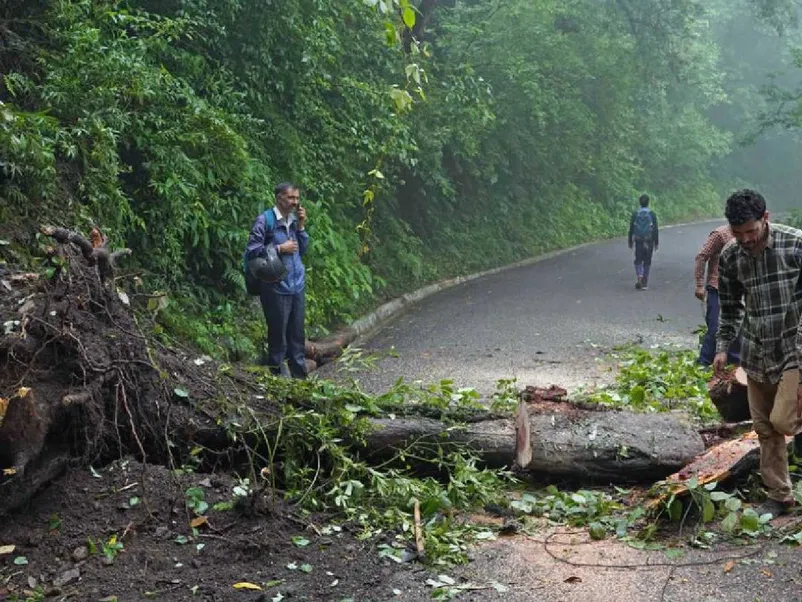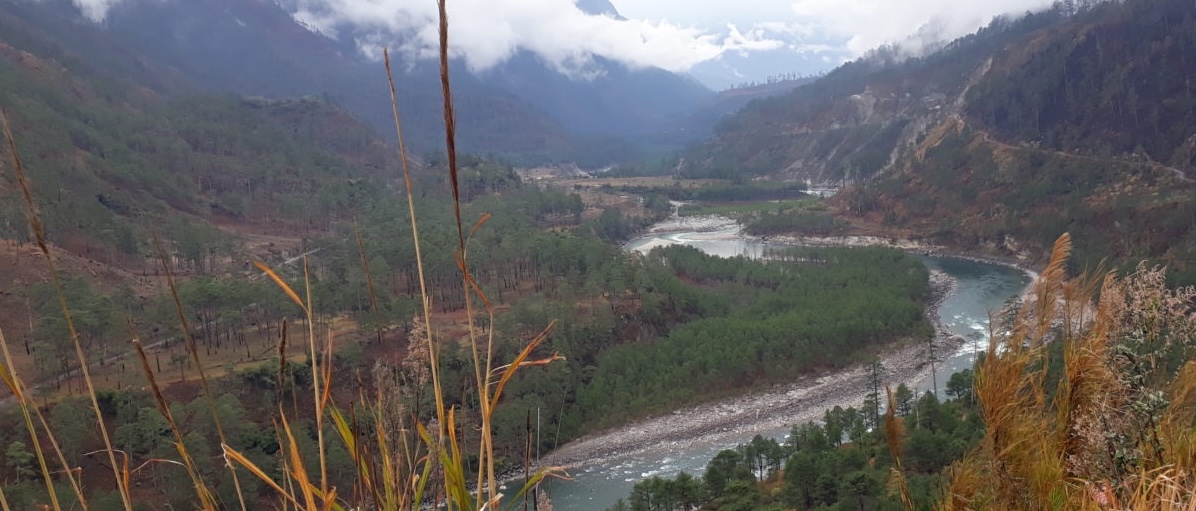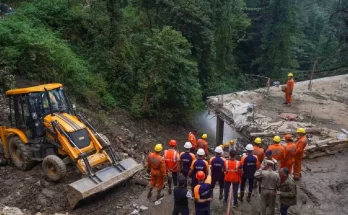Forests can be the best mitigation measures to prevent floods.

Photo for representational purpose only. (Credit: Twitter)
New Delhi: As extreme rainfall and floods left a trail of destruction in Himachal Pradesh on July 10, a video from Thunag village that went viral showed hundreds of logs hurtling down the narrow village street that had turned into a muddy stream after a cloud burst upstream.
The locals had alleged that those logs were dumped in the stream after a green patch was cut for a road to connect Thunag and Thandi, four kilometres upstream. More than a week after the incident, Thunag residents are still counting their losses.
But it is not just Thunag that faced the wrath of nature but large swathes of northwest India. And, many of these areas were areas that have seen degradation or wiping out of forests.
Government data shows that India’s forest cover is spread over 21% and only 12.37% of it is the natural forest, classified as ‘very dense’ and ‘moderately dense’ forest by the Forest Survey of India, an agency under the Ministry of Environment, Forest and Climate Change (MoEF&CC).
Experts have pointed out that even when the FSI reports have shown a marginal increase of 2,261 square km in forest cover over the last two years, large biodiversity-rich parts, such as the northeastern states that have shown a decline of 3,199 sq km over 10 years between 2009-2019.
Then, on the one hand, the government is also pushing for ‘Nagar Van Yojana’ that may witness more and more city forests, and on the other hand, it is also encouraging commercial plantations, a move opposed by environmentalists for its nature of being mono-culture in most of the cases.
It is where the Forest (Conservation) Amendment Bill, 2023 becomes crucial.
The Bill was introduced in Lok Sabha on March 29, 2023. Following the uproar by opposition and environmental activists, the Bill was referred to a Joint Committee of the Houses on the same day with the instruction to report by the last day of the first week of the next Session.
On Monday, July 17, the government put out the list of business to be carried out during the Monsoon session of Parliament starting July 20, and mentioned that this Bill would be presented “for consideration and passing after the Report of the Joint Committee is presented to Lok Sabha.”
Experts oppose drastic amendments
Two sets of people wrote to the government, especially Bhupender Yadav, Minister for Environment, Forest and Climate Change, and also to the Members of Parliament ahead of the Parliament Session that starts on Thursday, July 20
The first set of people, the Constitutional Conduct Group (688 signatories) are ecologists and conservationists who have spent decades working to research and conserve India’s ecosystems and the valuable services they provide. The second set (105 signatories) of people are former civil servants from all India and central services, who have spent lifetime in service in central and state governments.
Drawing attention to a sub-section that the FCA will only apply to areas recorded as forests in government records as on or after October 25, 1980 “adds confusion regarding the classification of forests in the country,” the ecologists and conservationists said, “This has raised legitimate fears that the amendment will invalidate the Supreme Court’s 1996 judgment in the T N Godavarman case, wherein the court had interpreted the meaning of the forest as its dictionary meaning and thus expanded the purview of FCA.”
“If these areas are declassified, it will mean that thousands of square kilometres of forests will lose protection overnight. Out of the total 7,13,789 sq kms of forests in India as identified by FSI, as much as 1,97,159 sq kms – 27.62% of total – will lose all protection,” the letter by conservationists and ecologists said.
The retired civil servants furnish startling statistics to make their point. “In the 30 years prior to 1980, about 4.2 million Ha forest land was lost, being diverted for non-forestry purposes. In over 40 years since the enactment of the FCA, 1980, only about 1.5 million Ha have been diverted. “Unfortunately, in the last few years, despite the adverse impacts of climate change becoming increasingly obvious, the diversion of forest land gathered pace. Between 2018-19 and 2022-23, almost 90,000 Ha of forest land has been diverted for non-forest use,” the retired civil servants said.
The government has claimed that the amendment will lead to forest and tree cover increase, which, in turn, will create a carbon sink of an additional 2.5 to 3.0 billion tonnes of CO2 equivalent by 2030.
Emphasizing that the amendments “need to be contextualised within the history of forest governance in India,” Kanchi Kohli, an independent law and policy researcher, said, “The changes look to incentivise tree plantations by easing regulatory oversight. If land regeneration and biodiverse plantations are intertwined with community rights, some experiments can result in creating against degradation, which are important for flood mitigation and soil.”
“However, the history of afforestation programmes have justifiably created a trust deficit that the present forest governance model will deliver an equitable conservation outcome,” she said.
“It (the government) puts its faith, apparently, in compensatory afforestation. There are ample studies that have suggested that natural forests are 40 times more efficient as carbon sinks than newly planted forests. India is one of the only 17 mega-diverse countries in the world with more than 5,000 endemic species of plants and animals. This myopic Bill threatens this biodiversity.”
FCA amendment threat to internal security
Commenting on the proposed exemptions for projects near border areas and for security purposes – which will remove the necessary prior forest clearance for defence projects within 100 kms of international borders – they said, “These areas are home to the most ecologically important ecosystem, including the forests of northeast India, the high altitude deserts of Ladakh and Spiti, the alpine forests of Uttarakhand and Himachal Pradesh and the open scrub and desert ecosystem of west India.
Echoing that ensuring military security of the country should not come at the cost of losing ecological security, Kohli said, “While state governments can still regulate land diversions, the broader framing of these projects being of national importance presents a challenge of understating ecological risks. It may be important to understand climate induced disasters as an internal security hazard, that also require highest levels of attention. It may be useful to deliberate on the proposed amendments also through this understanding.”
(This story first appeared on news9live.com on Jul 19, 2024 and can be read here.)



